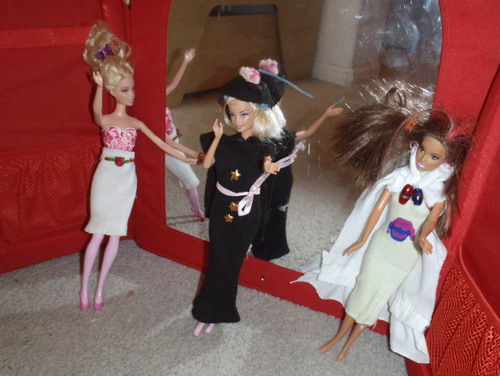LONDON ? St. Paul's Cathedral has welcomed visitors for 300 years, but for almost a week its heavy oak doors have been shut, locked because of an anti-capitalist protest camp outside the landmark building.
Church officials say the campsite is a health hazard, and on Wednesday London's Anglican bishop asked the demonstrators to leave. But the protesters are settling in for a long stay, and accuse the church of choosing the wrong side in the standoff between capitalism and idealism that has spawned sit-ins from New York to Sydney.
"We want this church to open," said a 50-year-old protest spokesman who gave his name as Akira. "We were shocked that they closed it."
The Dean of St. Paul's, Rev. Graeme Knowles, said Wednesday evening he was optimistic that the cathedral would reopen Friday following changes to the layout of tents used by the protesters.
The cathedral is considering all its options in response to the protest ? including legal action ? Knowles said, adding that a final decision would be made Thursday on whether St. Paul's could open in time for a midday service Friday.
In recent days authorities in several cities around the world have swooped in to evict encampments of anti-corporate demonstrators inspired by New York's Occupy Wall Street movement. But London's campsite has grown since protesters erected tents near the base of the cathedral steps on Oct. 15. They had hoped to camp outside the nearby London Stock Exchange, but were stopped by police. Cathedral officials initially permitted the protesters to stay.
The camp, perhaps 100 tents and 500 people strong, has the air of a scruffy village carnival, with banners, speeches, activities ? and even, one recent afternoon, a singalong. "Clowns to the left of me, jokers to the right," sang a small but enthusiastic group attempting a Stealers Wheel classic. "Here I am, stuck in the middle with you."
That is a fair summary of how cathedral officials feel. They say they support the right to demonstrate and did not want to shut the building ? for the first time since German bombers blitzed London during World War II ? but made the decision last Friday because the protesters' tents, stoves and generators pose a threat to public safety.
The closure is costing the cathedral thousands of pounds (dollars) a day ? St. Paul's charges adults 14.50 pounds ($23) for admission, unless they are attending a service ? and means disappointment for tourists hoping to visit Christopher Wren's domed church, one of London's most famous buildings and the site of the 1981 wedding of Prince Charles and Lady Diana Spencer.
On Wednesday, Bishop of London Richard Chartres, the third highest-ranking cleric in the Church of England, asked the protesters to go home, saying: "The camp's presence threatens to eclipse entirely the issues that it was set up to address."
The protesters say they have worked with health-and-safety officials to make sure the site is safe, and want to negotiate a compromise with the church.
The protest is less than two weeks old but has a semi-permanent feel. There is a kitchen dispensing donated food and water, a tent offering free "tea and coffee and empathy," a technology tent linking the camp to the world via the Internet, a music tent, a meditation tent, a library, a movie theater and a newspaper.
There are twice-daily meetings to plan strategy, and near-constant debates. The activists include many students and veteran protesters, but also, organizers say, doctors, shopkeepers and teachers.
Their demands are diverse, ranging from tighter control of banks to the complete dismantling of the capitalist system. But that diversity, the protesters say, is the point.
"This is a free space ? a free space for ideas, for discussions, for coming together and trying to brainstorm something, as a collective," said Emma Medoes, a student who works part time in a bar.
Similar camps have sprung up across the United States and around the world since activists took over a plaza near New York's Wall Street seven weeks ago to protest corporate greed and social inequality.
Most have withered or been dismantled, sometimes by force. On Tuesday police in Oakland, California, fired tear gas and bean bags to disperse about 170 protesters who had been camping in front of City Hall for the past two weeks. Police in Atlanta also moved in to break up a 2-week-old camp.
Several high-profile protests remain. In the hub of Asian capitalism, Hong Kong, 30 to 40 protesters are camped outside the headquarters of banking giant HSBC.
In Germany, crowds of several thousand demonstrated on Oct. 15 and again on Saturday, and a small camp has been pitched outside the headquarters of the European Central Bank in Frankfurt. But the protests have failed to catch fire in a country that has one of Europe's strongest economies.
As winter approaches in London, it's unclear whether the protest will prosper or shrink.
At the moment police can't remove the protesters, who technically are not trespassing ? they camped with the Cathedral's approval. A handful of people have been arrested for public disorder offenses since the protest began, but police say it has been mainly peaceful.
The local governing authority, the City of London Corporation, says it is taking legal advice on the best way to evict the protesters ? but that could be a long process.
An anti-war vigil outside Britain's Parliament has continued for 10 years, despite repeated legal attempts by local authorities to move it. A handful of die-hards remain, even though legal challenges have limited the protesters to the sidewalk, rather than the grass area of Parliament Square.
The issue is complicated because this patch of London dates back to medieval times, with complex ownership split between the local authority and the cathedral.
Bookmaker William Hill is taking bets on a reopening date, offering 50 to 1 odds on the building still being shut at Christmas.
The camp is drawing support from some of the tourists, office workers ? and even bankers ? who stop by the site to take photographs and chat. Many say they understand the anger at bankers at a time when economic crisis and government austerity are bringing rising unemployment, higher prices, scarcer services and dwindling pensions.
"I agree with some of the things they are saying," said David Pressman, a 19-year-old trainee investment banker. "I think there is a lot of greed from a small number of people."
The protest has already spawned a second, smaller camp, a mile (1.6 kilometers) away in Finsbury Square. But a local councilor claimed this week that infrared photographs revealed that 90 percent of the tents at St. Paul's were unoccupied at night as protesters returned home to hot showers and warm beds.
Camp organizers insist that most of the tents are occupied at night, saying there are plenty of newcomers willing to take over from those whose who have to leave.
Protester Malcolm Blackman, 44, said the photographs were probably taken before midnight ? when many demonstrators were in the pub.
"If you're going to have a tent city in the middle of London, you're going to enjoy London," he said. "We're not all so poor we can't afford a pint."
____
Associated Press Writers Juergen Baetz in Berlin and Peter Enav in Hong Kong contributed to this report.
Source: http://us.rd.yahoo.com/dailynews/rss/britain/*http%3A//news.yahoo.com/s/ap/20111026/ap_on_bi_ge/eu_britain_wall_street_protests
patti labelle db cooper jackie evancho wild flag wild flag frank lucas stevie wonder


